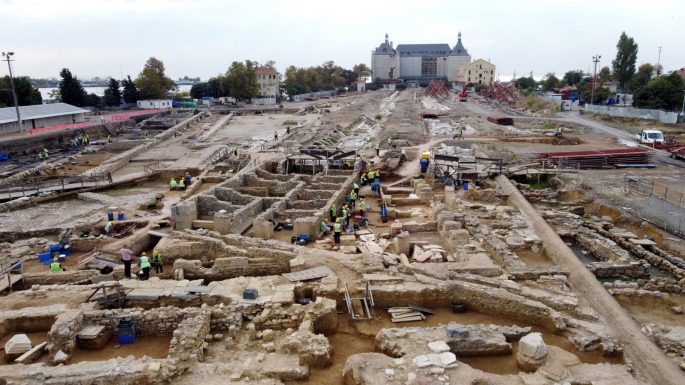Haydarpaşa Train Station excavations, which lasted 4 years, brought Istanbul to a huge treasure. Baths, residences, palaces, bowls and a coin that rewinds history… More than 50 thousand safes of artifacts were unearthed.
The excavations started at Haydarpaşa Train Station, where historical artifacts were located during the removal of its platforms, have been continuing for four years.
The excavations carried out in the region known as “Khalkedon” in ancient times and “Kadıköy” today are carried out by the Ministry of Transport and Infrastructure and the Ministry of Culture and Tourism.
During the excavations carried out on the 300-decare land just behind the Haydarpaşa Train Station, daily use vessels belonging to the Ottoman and Byzantine periods were unearthed for the first time.
As the excavation deepened, history rewinded. On the surface, the remains of the Republican and Ottoman Periods have illuminated different periods, layer by layer.
The deepest point is 5 meters
The ‘Kadıköy’ of ancient Istanbul also hosted the Roman, Byzantine and Hellenistic periods. Moreover, this historical journey has come to light with excavations, the deepest of which is 5 meters.



The ruins shed light on history starting from the 5th century BC. The most important of the remains of the Classical, Hellenistic, Byzantine, Roman, Ottoman and Republican periods was the Chalcedonian coin. According to historians, it is one of the rare finds that have survived from a completely dark period.
According to Yusuf Tokgöz, Art Historian of the Istanbul Archaeological Museums, the finds will shed light on the dark ages.
“We reached a tomb just below the platform. A cremated, cremated skeleton was found in this tomb. As a grave gift, 10 ungartariums were found in a bronze bowl right next to it. This means the most important big find for us.”
During the excavations, approximately 18 thousand coins were unearthed, the earliest dated to the 5th century BC. Yusuf Tokgöz puts the Chalcedonian coin found at the excavation site in a separate place.
“The earliest architectural find for us during the excavations at the Haydarpaşa Train Station is the tomb monument dating to the 2nd century BC. Among the coins found around this monument, the most important for us is the Chalcedonian coin dated to the 5th century BC. This coin has been in the museum until today, but it was found in this excavation for the first time in its own region, on its soil.”
50 thousand cases of artifacts are waiting for restoration
Except for coins, utensils, oil lamps and almost all materials produced for daily use are among the other historical finds recorded in the inventory. Emphasizing that the artifacts found under the ground are meticulously examined and classified chronologically, Tokgöz continues as follows:



“The artifacts unearthed during the excavation are first classified. The works that go to the workshops in crates are washed, while the ones that can be integrated and combined are delivered to the restoration. After restoration, those artifacts are complemented and taken into inventory. At the moment, nearly 50 thousand cases full of artifacts are waiting in line for restoration. The number of small works we take into inventory is one thousand and a hundred.”
Haydarpaşa Train Station will continue to function in the “Arkeopark” project
The excavations at Haydarpaşa Train Station, where three museum experts, 12 archaeologists and 150 workers are employed, are drawing to a close. The “Arkeopark” project also takes place in the works.
Stating that the Ministry of Transport and Infrastructure and the Ministry of Culture and Tourism are preparing a joint project for the archaeopark to be realized, Yusuf Tokgöz said, “The aim is to integrate the remains found in the excavation area with Haydarpaşa Train Station. As part of the project, Haydarpaşa Train Station continues to fulfill its routine function, while the architectural remains in the area can be visited by the visitors via the walking paths at the same time.”
Source: TrtHaber
